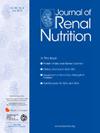Urine Albumin-creatinine Ratio Accurately Reflects Daily Albuminuria in Nonobese Patients but Requires Body Weight Correction in Obese
IF 3.2
3区 医学
Q2 NUTRITION & DIETETICS
引用次数: 0
Abstract
Objective
Urine albumin-creatinine ratio (UACR) is widely used to estimate daily albuminuria. Despite efforts to improve the accuracy of the estimated albumin excretion rate, the individual contributions of age, sex, and body weight remain unexplored.
Methods
This hospital-based cohort study examined the explanatory power of various factors and compared total R2 values across different sets of factors to determine the optimal estimated albumin excretion rate model.
Results
An analysis of 304 24-hour urine samples revealed a median value of 0.538 g (interquartile range: 0.091-2.080 g), identifying UACR and body weight as significant factors with high partial R2 values in estimating daily albuminuria. A novel model using only UACR and body weight demonstrated performance comparable to previous models that included additional variables (total R2 values: ours 0.922 vs. 0.923, P = .893; ours 0.922 vs. 0.925, P = .727), and outperformed the model that excluded body weight (total R2 values: ours 0.922 vs. 0.855, P < .001). Receiver operating characteristic analysis identified 78.1 kg (body mass index [BMI] of 28.5 kg/m2) as the optimal cutoff for predicting underestimation of daily albuminuria by UACR in the heavier half of our patient cohort (area under the curve: 0.865). For individuals with body weight less than 78.1 kg (0th-75.4th percentile), daily albuminuria (g) could be estimated as: 0.033 + 0.999 × UACR (mg/mg) (total R2: 0.966). Conversely, for those weighing ≥78.1 kg (75.5th-100th percentile), the estimation formula was as follows: −3.885 + 1.538 × UACR (mg/mg) + 0.045 × body weight (kg) (total R2: 0.942).
Conclusions
For individuals with a BMI below 28.5 kg/m2, the UACR alone provides sufficient accuracy for estimating daily albuminuria (using the formula: daily albuminuria (g) = 0.033 + 0.999 × UACR (mg/mg)). However, for those with a BMI of 28.5 kg/m2 or higher, adding body weight as a single correction factor to UACR sufficiently improves the explanatory power, simplifying clinical practice by eliminating the need for age and sex as additional factors.
UACR准确反映非肥胖患者每日蛋白尿,但肥胖患者需要体重矫正。
目的:尿白蛋白-肌酐比值(UACR)被广泛用于估算日蛋白尿。尽管努力提高估计白蛋白排泄率(eAER)的准确性,但年龄,性别和体重的个体贡献仍然未被探索。方法:以医院为基础的队列研究,检验各因素的解释能力,比较不同因素组间的总R2值,以确定最佳的eAER模型。结果:304份24小时尿液样本的中位值为0.538 g (IQR: 0.091-2.080 g),确定UACR和体重是估计每日蛋白尿的显著因素,其偏R2值较高。仅使用UACR和体重的新模型表现出与包含其他变量的先前模型相当的性能(总R2值:我们的0.922对0.923,p = 0.893;0.922比0.925,p = 0.727),并且优于排除体重的模型(总R2值:0.922比0.855,p < 0.001)。受试者工作特征分析发现,78.1 kg(体重指数(BMI)为28.5 kg/m2)是我们的患者队列中较重的一半患者UACR预测每日蛋白尿低估的最佳截止值(AUC: 0.865)。对于体重小于78.1 kg(第0 -75.4百分位)的个体,每日蛋白尿(g)可估计为:0.033 + 0.999 × UACR (mg/mg)(总R2: 0.966)。相反,对于体重≥78.1 kg(75.5 -100百分位),估算公式为:-3.885 + 1.538 × UACR (mg/mg) + 0.045 ×体重(kg)(总R2: 0.942)。结论:对于BMI低于28.5 kg/m2的个体,单独使用UACR对估算日蛋白尿有足够的准确性(使用公式:日蛋白尿(g) = 0.033 + 0.999 × UACR (mg/mg))。然而,对于那些BMI为28.5 kg/m2或更高的患者,在UACR中增加体重作为单一校正因素足以提高解释力,通过消除年龄和性别作为附加因素简化临床实践。
本文章由计算机程序翻译,如有差异,请以英文原文为准。
求助全文
约1分钟内获得全文
求助全文
来源期刊

Journal of Renal Nutrition
医学-泌尿学与肾脏学
CiteScore
5.70
自引率
12.50%
发文量
146
审稿时长
6.7 weeks
期刊介绍:
The Journal of Renal Nutrition is devoted exclusively to renal nutrition science and renal dietetics. Its content is appropriate for nutritionists, physicians and researchers working in nephrology. Each issue contains a state-of-the-art review, original research, articles on the clinical management and education of patients, a current literature review, and nutritional analysis of food products that have clinical relevance.
 求助内容:
求助内容: 应助结果提醒方式:
应助结果提醒方式:


